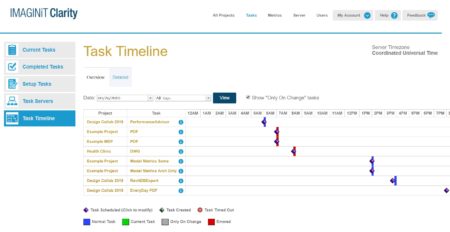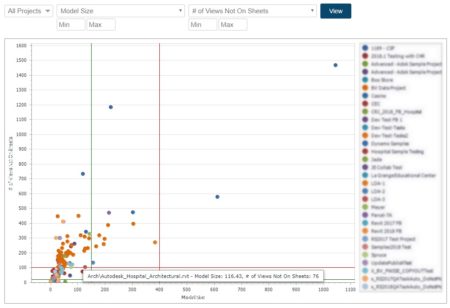IMAGINiT Clarity IS A POWERFUL TOOL FOR REVIT automation. Recently during AU 21 (Autodesk University), Architosh sat down virtually with Matt Mason, Director of Software Development, IMAGINiT Technologies, a division of RAND Worldwide. The goal was to review IMAGINiT Clarity and its latest updates.
Clarity—Its Role
Clarity is a product aimed squarely at the BIM Coordinator role in AEC firms using Revit as its BIM platform. The software has had four main functions: automation, model health, business intelligence, and room and equipment data. A new module just released this year addresses programming and space planning.
“This product goes back ten years, says Matt Mason. “We were looking at the people who serve firms in the BIM Coordinator role, and these folks seem to spend a large part of their time doing repetitive tasks.” Such tasks include the generation of DWG exports for consultants or producing PDF sets for next-day morning meetings. These basic tasks that all architects and engineers must do on large jobs can take mind-numbing hours per week.
People in the BIM Coordinator role have it tough; if a lot of staff are working on a project and the coordinator manages five or more projects, it is hard for them to spend much time in the models checking things and eyeballing if best practices are being followed. Clarity’s tools streamline this process.
Clarity enables BIM Coordinators to fully program and automate such tasks. “On just a medium-sized Revit project, this can take a half-hour, says Mason. “On a big Revit project, it can take a lot more time. Clarity is saving people a ton of time.”
Clarity can automate dozens of tasks across multiple functional categories. It can automate both exports and prints, including into file formats like DGN (Bentley), DWF, DWG, FBX, GBxml, COBie, IFC, Navisworks, and of course, PDF. It can also batch datasheet PDF books, send Revit schedules to Excel format, export Revit View images, including Room Images export.
BIM Models—Their Needs
High-functioning BIM models need attention, and dedicated BIM Coordinators best serve this role. Clarity comes with tools to power this process. BIM Coordinators can run Model Metrics, its Model Performance Advisor Report to gain insights into areas of a Revit model that are not meeting good practice standards. More than 60 metrics can be analyzed. (see Image 02 below)

Image 01 — Clarity can fully automate multiple types of tasks it can perform, shown here across its Task Timeline window.
“People in the BIM Coordinator role have it tough; if a lot of staff are working on a project and the coordinator manages five or more projects, it is hard for them to spend much time in the models checking things and eyeballing if best practices are being followed,” says Mason. “Clarity’s tools streamline this process.”
Firms using Revit and experiencing persistent slow-downs on models as the project proceeds through time would clearly benefit from IMAGINiT Clarity.
Another area where Clarity helps streamline tasks is in “model exchange” and management tasks. Clarity can simplify, clean, and fix links in Revit models.
Setting Up Clarity
Clarity installs on a Windows Server on your firm’s LAN. There is also a new cloud version of Clarity that runs on Autodesk Forge. The on-premise server version is one that Mason characterizes as light enterprise software.

Image 02 — Clarity delivers several tools aimed at BIM model metrics, optimizations, and performance advisory reports. These ensure optimal Revit model performance in organizations.
Clarity sends its marching orders to “task servers”—machines on the LAN running Revit (and optionally AutoCAD). The actual Revit models or AutoCAD files can exist elsewhere, including network (LAN) folders, on a Revit Server, Autodesk BIM 360, or Bentley ProjectWise. This flexibility is what is appealing to Revit users. Mason said they still have many customers committed to ProjectWise, for example, while the global pandemic pushed many Revit firms to BIM360.
Clarity has a growing list of “targets” for its output locations. When Clarity generates those PDFs at midnight for the next day’s morning meeting, the output locations include not only network (LAN) folders, BIM360, ProjectWise, and FTP; they also have support cloud players like BOX, Dropbox, Microsoft OneDrive, Microsoft SharePoint, MS Teams, Procore, and BIMTrack.
During AU with the big Clarity update, the company also announced integrations with Egnyte and deeper integration with Google Docs. They also have a Bluebeam integration which they hope to have active in the near future.

Image 03 — Clarity also includes a 3D Revit model viewer, as shown here highlighting a searched object in the project and providing data viewing of that object.
Clarity Cloud launched back in June of this year. This fully hosted version of Clarity can automate much of the same tasks as Clarity running on-premise. It can handle repetitive Revit, AutoCAD, and BIM 360 tasks, saving BIM Coordinators hundreds of hours every year.
Clarity Cloud runs on Autodesk Forge, which Mason said is still a “relatively young” product. The on-premise version of Clarity is still a more powerful version as Forge itself has limits as to what it can do.
“The Autodesk Forge side, in terms of automation, is still early. For example, you can’t print PDFs well, which is something people want,” says Mason. “Forge is really sitting in for the task server machines that are on-premise,” he adds, “and the benefit of those machines is you know the hardware, you know what they are capable of doing and how they perform because they are just like your production workstations.”
Some small to mid-sized customers may prefer Clarity Cloud, a solution that features a per-usage billing model while eliminating upfront hardware and IT-related costs. As Forge matures and its functionality and tasks are improved, the cloud version may offer new advantages over the on-premise version.
next page: Space Programming Module




Reader Comments
Comments for this story are closed